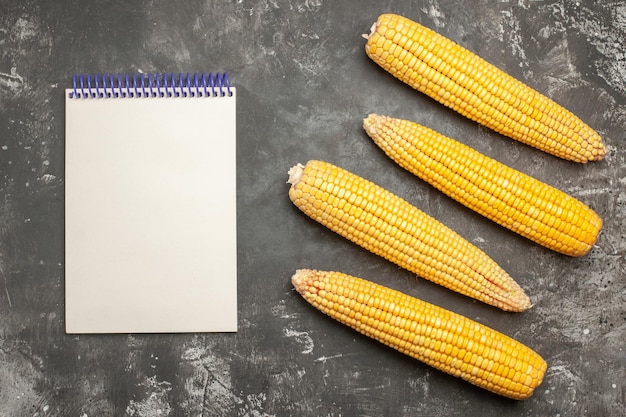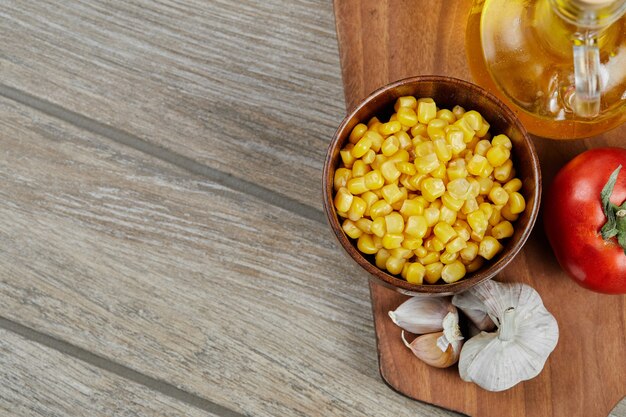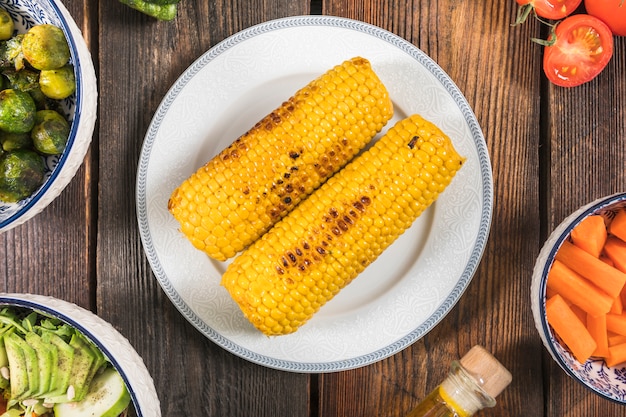Ah, corn. It’s a summer staple, a symbol of sunshine and backyard barbecues. But let's be honest, sometimes it feels like a bit of a mystery. You're staring at a pot of corn, wondering if it's done yet, praying you don't end up with a mushy mess. Been there, done that. So, after countless experiments in my own kitchen, I've decided to share my secrets to perfectly cooked corn, no matter how you like to enjoy it.
Part 1: Getting to Know Corn

Before we dive into the cooking methods, let's get a bit of background on this versatile, adaptable crop. A little knowledge goes a long way when it comes to achieving delicious results.
1.1 Types of Corn
You'll find a whole rainbow of corn varieties at the market, but the ones we're focusing on here are the ones commonly used for cooking. There are four main types to consider:
- sweet corn: The classic. This is the one you'll most likely find in the supermarket and it's the perfect choice for grilling, boiling, or roasting. Its natural sweetness and juicy kernels make it a true delight.
- field corn: This type is more for animal feed or industrial use, but sometimes you might find it at farmers markets. It's not as sweet as sweet corn and has a harder texture.
- flint corn: Also known as Indian corn, this type has a unique, hard, dent-like kernel. It's often used for making hominy or grits.
- Popcorn: Well, this one is pretty self-explanatory! It's specially bred to pop when heated.
1.2 Choosing the Right Corn
The secret to delicious corn starts with fresh, high-quality ears. Here's how to choose the best ones:
- Freshness: Look for corn with green, moist husks. Avoid ears with dry, brown husks, as they've likely been sitting around for a while. The silk should be brown and dry, indicating the corn is ready for picking.
- Firmness: The ears should feel firm and full, not soft or shriveled. This is a good indicator of freshness.
- Kernels: The kernels should be plump and tightly packed, not small and loose. They should also be a vibrant, creamy yellow color.
1.3 Preparing the Corn
Once you've got your perfect corn, it's time to get it ready for cooking. Here's the basic prep:
- Shucking: Remove the husks and silk. I always like to give the ears a quick rinse under the tap to wash off any dirt or debris.
- Removing the Husk (For Grilling): If you're planning to grill the corn, you can leave the husk on but strip back the leaves and remove the silk. The husk will act like a natural steamer, helping to cook the corn evenly.
Part 2: The Art of cooking corn

Now for the fun part: cooking the corn! We'll explore several methods, each with its own unique charm and flavor profile.
2.1 Boiling: The Classic Method
Boiling is the classic way to cook corn, and for good reason. It's simple, reliable, and results in tender, sweet corn. Here's how I do it:
- Fill a large pot with enough water to cover the corn ears comfortably. Don't overcrowd the pot or the corn won't cook evenly.
- Add salt to the water (about a tablespoon per gallon). This enhances the flavor of the corn and prevents it from becoming bland.
- Bring the water to a rolling boil before adding the corn. This ensures the corn cooks evenly and quickly.
- Add the corn and return to a boil. Then, reduce the heat to a gentle simmer.
- Simmer for 5-7 minutes, or until the kernels are tender. You can test them by piercing a kernel with a fork. It should be tender but not mushy. If you overcook it, the kernels will become mushy and lose their flavor.
- Drain the corn and serve immediately. It's best to enjoy it while it's still hot, as the flavors will be most intense.
2.2 Grilling: The Smoky Delight
grilling corn gives it a smoky, chargrilled flavor that's hard to resist. Here's how to grill corn to perfection:
- Prepare the corn: As mentioned before, you can leave the husks on, but strip back the leaves and remove the silk. This allows the heat to penetrate the corn while still keeping it moist.
- Preheat the grill to medium heat. I prefer a gas grill, but a charcoal grill works just fine.
- Place the corn directly on the grill grates and cook for 10-15 minutes, turning occasionally to ensure even browning.
- Add butter, salt, and pepper to taste once the corn is cooked. You can also get creative with other seasonings like garlic powder, paprika, or chili flakes.
2.3 Roasting: Crispy and Delicious
roasting corn in the oven results in a crispy exterior and a tender, flavorful interior. Here's how to roast corn to perfection:
- Preheat your oven to 400°F (200°C).
- Prepare the corn: Remove the husks and silk.
- Brush the corn ears with melted butter or olive oil. This helps the corn to brown and creates a lovely crispy texture.
- Season with salt, pepper, and any other herbs or spices you like. Some popular choices include garlic powder, onion powder, paprika, or chili flakes.
- Place the corn ears on a baking sheet.
- Roast for 20-25 minutes, or until the kernels are tender and slightly browned. You can test the tenderness by piercing a kernel with a fork.
2.4 Microwave: A Quick and Easy Option
Need a quick and easy method? The microwave can actually do a decent job of cooking corn. Here's how:
- Prepare the corn: Remove the husks and silk.
- Wrap each ear of corn in a damp paper towel. This helps to steam the corn and prevent it from drying out.
- Microwave on high power for 3-5 minutes, or until the kernels are tender. You may need to adjust the cooking time based on the power of your microwave.
Part 3: Flavour Adventures

Once you've mastered the basic cooking methods, it's time to get creative with flavors. Here are a few ideas to elevate your corn game:
3.1 Herbed Corn: A Classic for a Reason
A sprinkle of fresh herbs takes corn to a whole new level. Parsley, chives, dill, and thyme are classic choices, but feel free to experiment with others like oregano, basil, or rosemary. You can add the herbs to the boiling water, sprinkle them on the corn before grilling, or even mix them with butter for a flavorful topping.
3.2 Spicy Corn: A Touch of Heat
For those who like a bit of heat, a sprinkle of chili flakes, cayenne pepper, or a dash of hot sauce can add a kick to your corn. This is especially good with grilled or roasted corn, as the heat complements the smoky flavor.
3.3 Sweet Corn: Embracing the Sweet Side
For those who love sweetness, a drizzle of honey or maple syrup can take your corn to the next level. Combine it with a sprinkle of cinnamon or nutmeg for a touch of warmth. You can even add a bit of brown sugar to the boiling water for a subtle sweetness.
3.4 Cheesy Corn: A Crowd Pleaser
Who doesn't love cheese on corn? Sprinkle grated Parmesan, cheddar, or mozzarella on your cooked corn. You can even add a dollop of sour cream or cream cheese for a richer flavor. For a truly decadent experience, try a combination of cheeses!
3.5 corn salad: Beyond the Cob
If you're looking for something a bit more adventurous, try a corn salad. Mix cooked corn with your favorite ingredients, such as tomatoes, bell peppers, onions, cilantro, lime juice, and a vinaigrette dressing.
Part 4: Storing Corn for Future Enjoyment
fresh corn is best enjoyed immediately, but if you need to store it, here are some tips:
4.1 Storing Fresh Corn: Keeping It Fresh
Keep fresh corn in the refrigerator, wrapped in plastic bags or damp paper towels. It will last for 2-3 days this way. Make sure to choose ears with green, moist husks for the best results.
4.2 Freezing Corn: For Longer Storage
For longer storage, you can freeze corn. Here's how:
- Blanch the corn: Bring a pot of salted water to a boil. Add the corn and blanch for 3-5 minutes. Remove the corn and immediately plunge it into ice water to stop the cooking process. Blanching helps to preserve the color, texture, and flavor of the corn.
- Remove the kernels: Cut the kernels off the cob and place them in a freezer-safe bag or container. You can also freeze the whole corn cobs by wrapping them individually in plastic wrap and placing them in a freezer bag.
- Freeze: Label the bag or container with the date and freeze for up to 6 months. frozen corn can be used in soups, stews, casseroles, and other dishes.
Part 5: Corn Beyond the Cob: Exploring the Possibilities
Corn isn't just about eating it off the cob. It's a versatile ingredient that can be used in a wide range of dishes.
5.1 Cornbread: A Southern Classic
This classic comfort food is a must-try! From sweet to savory, cornbread is incredibly versatile. It's a perfect pairing for chili, stews, or even as a side dish with a hearty meal.
5.2 Polenta: Creamy and Delicious
Polenta is a creamy, savory dish made from ground cornmeal. It can be served as a side dish, a base for other ingredients, or even used in desserts.
5.3 Corn Chowder: A Comforting Classic
Creamy, comforting, and bursting with flavor, corn chowder is a classic soup that's perfect for a chilly day.
Part 6: A Journey Through Corn's History
Corn has a fascinating history, originating in Mexico and spreading throughout the Americas and the rest of the world. Here are some interesting facts:
- Corn's Ancient Roots: Corn was first domesticated in Mexico about 9,000 years ago. It was a staple crop for ancient civilizations like the Aztecs and Mayans.
- Columbus and the Spread of Corn: Christopher Columbus brought corn back to Europe in the 15th century. It quickly became popular and spread to other parts of the world.
- A Global Staple: Today, corn is one of the most widely grown crops in the world. It's used for food, feed, and even biofuel.
Part 7: Corn in Cultures Around the World
Corn is more than just a food; it's embedded in cultures around the globe. Here are a few examples:
- Native American Cultures: Corn is a sacred plant in many Native American cultures, often associated with life, growth, and fertility.
- Mexican Cuisine: Corn is a cornerstone of Mexican cuisine, used in dishes like tortillas, tamales, and pozole.
- Southern US Cuisine: Cornbread, cornbread dressing, and corn fritters are staples in Southern US cooking.
Part 8: Fun Facts about Corn: A Few Surprises
Let's end this corn exploration with some fun facts:
- Kernel Power: A single corn plant can produce up to 2,000 kernels. That's a lot of corn!
- The World's Largest Corn Maze: The largest corn maze in the world is located in Nebraska, USA. It covers over 70 acres. I can only imagine how long it would take to get lost in that maze!
- The Magic of Popcorn: Popcorn is actually a type of corn that was bred to pop. When heated, the moisture inside the kernel turns to steam, causing it to explode. It's a truly fascinating process!
FAQs: Your Corn Questions Answered
Here are some frequently asked questions about corn:
8.1 What's the Best Way to Cook corn on the cob?
That depends on your preference! If you want a classic flavor, boiling is a great option. For smoky flavor, grilling is ideal. If you're looking for a crispy exterior, roasting is the way to go. And if you need a quick and easy method, the microwave will get the job done.
8.2 How Long Does It Take to Cook Corn on the Cob?
Here's a quick guide to the cooking times:
| Method | Cooking Time |
|---|---|
| Boiling | 5-7 minutes |
| Grilling | 10-15 minutes |
| Roasting | 20-25 minutes |
| Microwave | 3-5 minutes |
8.3 What's the Best Way to Store Corn on the Cob?
Store fresh corn in the refrigerator for 2-3 days, wrapped in plastic bags or damp paper towels. For longer storage, freeze the corn.
8.4 What's the Difference Between Sweet Corn and Field Corn?
Sweet corn is bred for its sweetness and is typically used for eating fresh. Field corn is primarily used for animal feed or industrial purposes. It's generally not as sweet as sweet corn.
8.5 Can I Eat the Silk on Corn?
No, it's best to remove the silk before cooking. It can be tough and stringy.
Everyone is watching

How to Cook Frozen Lobster Tails Perfectly: A Step-by-Step Guide
RecipesLobster. Just the word conjures up images of lavish meals, special occasions, and a taste of luxury. But let's...

Pork Fillet Cooking Time: How Long to Cook It Perfectly
RecipesPork fillet, or tenderloin as it's sometimes called, is a real favourite in our house. It's so versatile, and...

Pigs in a Blanket Cooking Time: How Long to Bake for Perfect Results
RecipesAh, pigs in a blanket. Just the name conjures up images of those delightful little parcels of crispy pastry en...

The Ultimate Guide to Cooking Delicious Frankfurters
RecipesLet's face it, we all love a good frankfurter. It's a classic, simple, and always satisfying. But let's be rea...

Wolf Meat Recipes: A Guide to Cooking Wild Game
RecipesLet's be honest, you don't see wolf meat at your local butcher shop every day. It's a bit of a wild card, but ...
